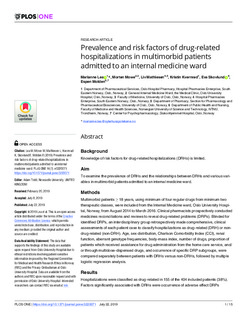| dc.description.abstract | Background
Knowledge of risk factors for drug-related hospitalizations (DRHs) is limited.
Aim
To examine the prevalence of DRHs and the relationships between DRHs and various variables in multimorbid patients admitted to an internal medicine ward.
Methods
Multimorbid patients ≥ 18 years, using minimum of four regular drugs from minimum two therapeutic classes, were included from the Internal Medicine ward, Oslo University Hospital, Norway, from August 2014 to March 2016. Clinical pharmacists prospectively conducted medicines reconciliations and reviews to reveal drug-related problems (DRPs). Blinded for identified DRPs, an interdisciplinary group retrospectively made comprehensive, clinical assessments of each patient case to classify hospitalizations as drug-related (DRH) or non-drug-related (non-DRH). Age, sex distribution, Charlson Comorbidity Index (CCI), renal function, aberrant genotype frequencies, body-mass index, number of drugs, proportion of patients which received assistance for drug administration from the home care service, and/or through multidose-dispensed drugs, and occurrence of specific DRP subgroups, were compared separately between patients with DRHs versus non-DRHs, followed by multiple logistic regression analysis.
Results
Hospitalizations were classified as drug-related in 155 of the 404 included patients (38%). Factors significantly associated with DRHs were occurrence of adverse effect DRPs (adjusted odds ratio (OR) 3.3, 95% confidence interval (CI) 1.4–8.0), adherence issues (OR 2.9, 1.1–7.2), home care (OR 1.9, 1.1–3.5), drug monitoring DRPs (OR 1.9, 1.2–3.0), and CCI score ≥6 (OR 0.33, 0.14–0.77). Frequencies of aberrant genotypes did not differ between the patient groups, but in 41 patients with DRHs (26.5%), gene-drug interactions influenced the assessments of DRHs.
Conclusion
DRHs are prevalent in multimorbid patients with adverse effect DRPs and adherence issues as the most important risk factors. | nb_NO |

